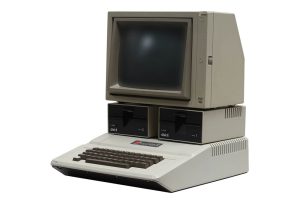
Xbox360 Wireless Steering Wheel – Great addition to your Xbox collection
24th November 2024
History of game consoles by generation- 1972 to today – see how far we’ve come
9th December 2024How fast are computers developing – and what if car were progressing as fast?
On this channel we have a lot of fun playing with older computers and technology. It all works well, and we can still have lots of fun with the games and consoles, but of course the machines are far behind the latest, most powerful hardware on the market today. But sometimes it’s hard to visualise just how far behind these retro computer systems actually are.
You’ve probably heard of Moore’s Law for computing power where Gordon Moore, one of the founders of Intel, noticed the number of transistors that you could fit onto an integrated circuit was doubling every 2 years. This was back in 1965 and people thought it might continue at that rate for a decade or so. Sixty years later it’s still a fairly accurate benchmark.
So, using that equation we should now have about 2 ^ 30 times more computing power on our desktop compared to 1965. That’s just over 1 billion times more powerful. But is that true? Even comparing to a 1980’s 8 bit computer we should be over a million times better. A million times more powerful or even a billion times is hard to visualise.
So in this video we’ll have a look at the claims and then try to get a grasp of just how far computers have progressed. We’ll then compare computer technology advances to something more tangible, car technology, and see which set of engineers have been working the hardest.
So, let’s get ready for a bit of research and a bit of maths.
Increased Computing Power
Let’s start by looking at your desktop computer. We’ll use the Apple range of computers as they’ve probably been around for the longest.
If we go back to the 1977 we get to their first really usable computer, the Apple II.

This is an 8 bit computer powered by the good old 6502 running at a blistering, for the time, 1MHz. If you had enough money you could team this with a whopping 48KB of RAM and add a disk drive to store your data on 114KB 5.25 inch floppy disks. All this would set you back around $3000 or £2400. Allowing for inflation that’s equivalent to around $16000 or £12500.
In terms of computing power a lot of people use the processor clock speed, But I don’t think that really gives a true picture these days with multiple cores and modern architectures. So we’ll use computing power measured in the number of calculations the hardware can do per second. This is measured in floating point operations per second or FLOPS.
The 6502 doesn’t have built in support for floating point so we’ll have to estimate its power based on it doing a number of integer operations to generate a floating point calculation. The general measure seems to be about 40 instructions per calculation. This then gives us the 6502 running at around 25000 FLOPS.
In 1977 this was considered a premium device for a home user.
Fast forward to 2024 and we can use Apple’s latest top of the range desktop, the Apple Mac Pro.

So this device uses Apple’s latest M2 processor which is a 28 core CPU running at 3.5GHz. Again if you can afford Apple’s prices you can team this with up to 192GB of RAM and an 8TB SSD. So this nice little package will set you back around $7000 or, rather disappointingly, £7000. Why do we pay more in the UK?
Looking at processing power of the CPU, and we’re ignoring the GPU to keep it simple, we’ve got a massive 27.2 teraflops. That’s 27,000,000,000,000 FLOPS!
Comparing Old and New
So let’s line up these figures and see how well the electronics engineers have done over the past 47 years.
Top billing has to go to processing power. This is sort of what Moore’s Law is hinting at with the transistor count, but obviously it’s quite a bit more complicated than just that.
So our 1977 Apple II managed 25KFLOPS, our lastest Mac Pro 27.2 TFLOPS.
That’s an increase of 1 billion times (that’s 10^9 or 1000 million to keep our US friends happy rather than the bigger and, in my opinion, better UK billion of a million million!).
That number seems a lot more than Moore’s Law predicted at around 1 million times better, but if we factor in the predicted increased density of transistors as 1 million times better, multiplied by the 1000 fold increase in clock speed from MHz to GHz we do come out at our 1 billion figure. Well done Mr Moore!
Cars
So we’ve got an idea of how far computers have come from a first generation machine to the latest model.
How does this compare to automotive engineering? Let’s see if the engineers at Porsche have been keeping up.

The iconic Porsche 911 was launched in 1964. It had a 145 horse power engine that gave it a top speed of 132mph and a 0-60mph time of 9.0s. You’d only get about 15 miles per gallon of petrol but even so, these were all great figures for the day. All of this would set you back about $6500, which is equivalent to around $65000 in today’s money.

One of the current Porsche 911 models is the Porsche 992 GT3. This is a 510hp car that can hit 199mph and reach 60 mph from standstill in only 3.4 seconds. It will still only do 14 miles per gallon and will set you back around $180000.
So we want to be able to compare car development with computer development.
Cost is straight forward.
To compare top speed, we’ll use computing power as that’s a good measure of how fast the computer is.
For engine power let’s use processor clock speed, why not? If you do have a better idea then do please let me know in the comments.
For 0-60 time we’ll use RAM as we all know that you need RAM to keep that speed up.
Miles per gallon is a bit more tricky. If we think about how far the car has gone and how much fuel it’s used we can compare that to how many calculations the computer can do on a certain amount of electrical power. If we use the power rating of the whole computer we can calculate the number of Joules of energy it uses per second and we already know the number of calculations it can do. This will give us a calculations per Joule figure. At 35W for the Apple II we get 714 FLOPS or calculations per Joule. For the Mac Pro at 250W we get 100 GFLOPS/J
So let’s compare our car engineering and electronics engineering.
Cost
Cars have gone up in price by almost 3 fold in real terms. Computers have halved their cost.
Power
Cars have almost quadrupled their engine power. Computer clock speeds are now one thousand times faster.
Acceleration
Our Porsche now gets to 60mph in a third of the time, so a three fold increase in acceleration. Our computer RAM is now 4 million times larger than in 1977.
Top Speed
Let’s be kind and say that Porsche have managed to double the speed of their cars in 60 years. Apple have made their computers 1 billion times faster.
Fuel Economy
Well!! The automotive industry hasn’t really made any significant improvements in fuel economy, especially at the performance end. On the computing side we’re now 140 million times more efficient.
So Where Should Car Technology Be?
I guess this shows just how much better electronic engineers, like me, are than mechanical and aeronautical engineers in the car industry. So let’s take a look and what the specs of the latest Porsche could have been if they had ditched all the ‘hit it with a hammer people’ and used electronics experts.
So let me reveal to you the new Porsche ZX24 Turbo Super GT Targa XP.

Powered by the latest 145 000 hp engine giving it a 0-60 acceleration time of 2.5 millionths of a second (microseconds) and a top speed of 132 billion miles per hour. It’s still going to cost you around $33000 but fuel economy is a tad better at 2 billion miles per gallon. That’s a trip to Saturn and back in under one minute for about $5 or £5.
Conclusion
Hopefully you’ve had a bit of fun playing around with these stats. But I do hope it does bring home to you just how far we’ve come with our computer technology, and, if Moore’s Law continues to hold, how far we could go.
I know there’s a lot of talk in the AI community about the idea of the singularity, when computers reach the same levels of processing power and artificial intelligence as the human brain. As you can see it’s probably not as far away as it might seem.
Photo credits
Porsche 911 – By Michael Barera, CC BY-SA 4.0, https://commons.wikimedia.org/w/index.php?curid=20345650
Porsche 992 – By Alexander Migl – Own work, CC BY-SA 4.0, https://commons.wikimedia.org/w/index.php?curid=117761925
Apple II – By Rama & Musée Bolo – Own work, CC BY-SA 2.0 fr, https://commons.wikimedia.org/w/index.php?curid=36639527
Apple Mac Pro – By 17jiangz1 – Own work, CC BY-SA 4.0, https://commons.wikimedia.org/w/index.php?curid=88270336




